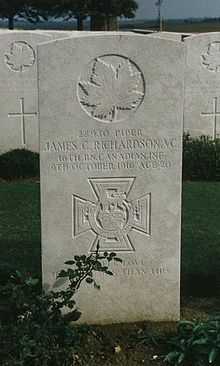James Cleland Richardson
| James Cleland Richardson | |
|---|---|
 Piper James C. Richardson, VC, circa. 1914-15 | |
| Nickname | Jimmy |
| Born |
25 November 1895 Bellshill, Scotland |
| Died |
8/9 October 1916 Somme, France |
| Buried at | Adanac Military Cemetery |
| Allegiance |
|
| Service/branch | Canadian Expeditionary Force |
| Years of service | 1914 - 1916 |
| Rank | Piper |
| Unit | 16th (Canadian Scottish) Battalion, CEF |
| Battles/wars | First World War † |
| Awards | Victoria Cross |
James (Jimmy) Cleland Richardson VC (25 November 1895 – 8/9 October 1916) was a Canadian recipient of the Victoria Cross, the highest and most prestigious award for gallantry in the face of the enemy that can be awarded to British and Commonwealth forces.
Ricahrdson was born in Bellshill, Scotland and a resident of Vancouver, British Columbia, Canada and then Chilliwack, BC. He was a Piper in the 72nd Seaforth Highlanders of Canada and he proceeded overseas as part of the large Seaforth contingent of the 16th (Canadian Scottish) Battalion, Canadian Expeditionary Force, during the First World War when the following deed took place when was 20 years old for which he was awarded the VC.
During the Battle of the Ancre Heights on 8 October 1916 at Regina Trench, Somme, France, the company was held up by very strong wire and came under intense fire. Piper Richardson, who had obtained permission to play the company 'over the top' strode up and down outside the wire playing his pipes, which so inspired the company that the wire was rushed and the position captured. Later the piper was detailed to take back a wounded comrade and some prisoners, but after proceeding some distance he insisted on turning back to recover his pipes which he had left behind. He was never seen again.
Richardson's remains were found in 1920 and he is buried at Adanac Military Cemetery, located 6 miles north-east of Albert, France (plot III, row F, grave 36).

Richardson's Bagpipes
Richardson's bagpipes were believed to have been lost in the mud of the Somme for almost 90 years until 2002, when the Pipe Major of The Canadian Scottish Regiment (Princess Mary's) responded to an Internet posting. He discovered that Ardvreck preparatory school in Scotland had possession of a set of bagpipes with the unique Lennox tartan on them, the same tartan used by the pipers of the 16th (Canadian Scottish) Battalion. A British Army Chaplain, Major Edward Yeld Bate, had found the pipes in 1917 and brought them back home after the war to a school in Scotland where he was a teacher. The pipes were unidentified for several decades, and served as a broken, mud-caked, and blood-stained reminder of an unknown piper from the Great War.
Andrew Winstanley of The Canadian Club and Pipe Major Roger McGuire were largely responsible for the investigative work into identifying Richardson's pipes. With the support of The Canadian Club and a group of patriotic citizens, Pipe Major McGuire travelled to Scotland in January 2003 to help identify the pipes that had been displayed at Ardvreck School in Crieff, Perthshire, Scotland, for over seven decades. Tomas Christie, a parent of students there and also a piper, initiated the search for the origin of the pipes.
Their collective effort led to conclusive evidence that identified the pipes as those played by Piper Richardson on that fateful day in 1916. An anonymous donor facilitated the purchase of the pipes on behalf of the citizens of Canada. In October 2006, a party of dignitaries visited Scotland and received the pipes from the Headmaster of Ardvreck School for repatriation to Canada.[1]
On 8 November 2006, the bagpipes were officially repatriated when troops from The Canadian Scottish Regiment (Princess Mary's) placed them at the British Columbia Legislature as a reminder of a generation's valour. They are currently on public display. There is a statue of him on display at the museum in Chilliwack, BC.


References
- Monuments to Courage (David Harvey, 1999)
- The Register of the Victoria Cross (This England, 1997)
- Scotland's Forgotten Valour (Graham Ross, 1995)
- VCs of the First World War - The Somme (Gerald Gliddon, 1994)
External links
| Wikimedia Commons has media related to James Cleland Richardson. |
- The Canadian Scottish Regiment (Princess Mary's) Warrant Officers' and Sergeants' Mess (Piper James Cleland Richardson entry)
- Biography at the Dictionary of Canadian Biography Online
- JAMES CLELLAND RICHARDSON (service/personal details, photograph, citation, relevant documents, burial information)
- Piper Richardson Statue (Master Sculptor John Weaver was commissioned to create a life size bronze sculpture of Piper Richardson in Chilliwack, BC, Canada)
- Legion Magazine article on James Richardson
- Find-A-Grave profile for James Cleland Richardson
- Richardson's Medals at the Canadian War Museum
- Movie with data about Richardson and other pipers of WWI